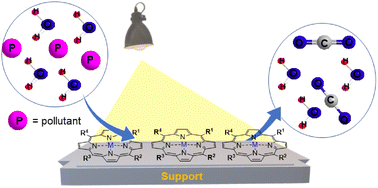Porphyrin-containing materials for photodegradation of organic pollutants in wastewaters: a review
Abstract
Industrialization and town urbanization have led to an exponential need for clean water and new wastewater treatment strategies. Currently, photocatalysis is the most appealing method to destroy organic pollutants in water, and the use of sunlight, with the assistance of a solid photocatalyst, is considered one of the most sustainable approaches. The use of heterogeneous photocatalysts has unique advantages, namely their recovery and reuse for several cycles without loss of activity. Due to their remarkable optical and photophysical properties, porphyrin (Por) dyes can be used in homogenous and heterogeneous photocatalysis. Different supports can be used to immobilize Pors, allowing the final material to extend its absorption into the white light region since most of the supports only absorb UV light. This review focuses on the photocatalytic performance of non-immobilized and immobilized porphyrins in the photodegradation of organic pollutants for wastewater treatment application.

- This article is part of the themed collection: Catalysis Science & Technology Recent Review Articles, 2024


 Please wait while we load your content...
Please wait while we load your content...